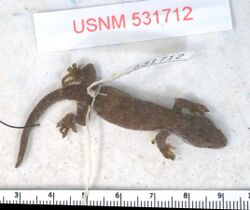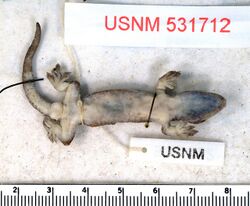Biology:Lepidodactylus tepukapili
| Lepidodactylus tepukapili | |
|---|---|

| |
| Top view of Lepidodactylus tepukapili | |

| |
| Bottom view of Lepidodactylus tepukapili | |
| Scientific classification | |
| Domain: | Eukaryota |
| Kingdom: | Animalia |
| Phylum: | Chordata |
| Class: | Reptilia |
| Order: | Squamata |
| Family: | Gekkonidae |
| Genus: | Lepidodactylus |
| Species: | L. tepukapili
|
| Binomial name | |
| Lepidodactylus tepukapili | |
Lepidodactylus tepukapili is a species of gecko, which is known as the Tuvalu forest gecko and is known in the Tuvaluan language as moko or pili.[1] It is the only recorded vertebrate that is endemic to Tuvalu.[2][3] It has been located on Fuagea (also called Fuakea) and on Tepuka.[2][4]
Lepidodactylus tepukapili's naming is based upon the Tuvaluan language words for "small lizard" and the island of Tepuka, where specimens were first discovered.[5]
In 2021, the IUCN published its assessment of the Tuvalu forest gecko, classifying it as Critically Endangered due to the ongoing threat of sea-level rise, as related to anthropogenic climate change. The two small low-lying islands on which it occurs average just 2 metres above sea level. IUCN Red List.[6]
References
- ↑ Randy Thaman; Feagaiga Penivao (2017). "Report on the 2016 Funafuti Community-Based Ridge-To-Reef (R2R)". Rapid Biodiversity Assessment of the Conservation Status of Biodiversity and Ecosystem Services (BES) in Tuvalu. https://www.sprep.org/attachments/VirLib/Tuvalu/r2r-biorap.pdf. Retrieved 25 May 2019.
- ↑ 2.0 2.1 George R. Zug; Dick Watling; Tataua Alefaio; Semese Alefaio; Claudia Ludescher (2003). "A new gecko (Reptilia: Squamata: Genus Lepidodactylus) from Tuvalu, South-central Pacific". Proceedings of the Biological Society of Washington 116 (1): 38–46. http://pdfs.semanticscholar.org/bf9d/e21e2650ab9d293432fb3323133e02e4f1a9.pdf.
- ↑ Lepidodactylus tepukapili at the Reptarium.cz Reptile Database
- ↑ "Lepidodactylus tepukapili Zug, Watling, Alefaio, Alefaio & Ludescher". polynesian diversity. 12 February 2012. http://www.pacificdisaster.net/pdnadmin/data/original/TUV_2011_Funafuti_StrageticPlan.pdf. Retrieved 25 May 2019.
- ↑ Lepidodactylus tepukapili. Reptile Database. Retrieved February 2, 2022.
- ↑ Tuvalu Sixth National Report to the Convention on Biological Diversity. Ministry of Public Works, Labour, Meteorology and Disaster. Government of Tuvalu. 2020. p. 79. Retrieved February 2, 2022.
Wikidata ☰ Q5072046 entry
 |

